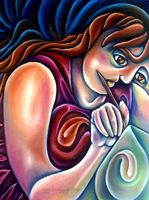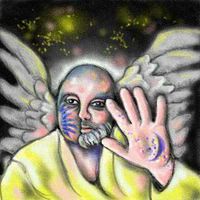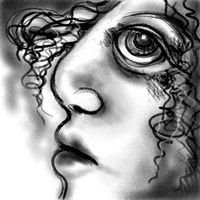
P258 Figure reading Brachiopod
36x24" oil on canvas
private collection
April 12, 1999: The direction my series work has taken is also distracting me. What is it doing? What do the fossils really mean? Ancient. Immutable. Carved in stone. Petrified viscera. Why are my characters so interested in them? They are looking deeply into the past, looking for patterns. Yes, our own viscera, and the chemistry of our own brains, is attracted to, yearns for those patterns repeated through the millennia. We see the same spirals, the same V-shapes everywhere. The stone books of the past are open to us, if we will pause to read them.
Even the colours I am using now are fleshier, more earthy. Always searching, reviewing, what will I see this summer when the earth comes to life again, in bloom and leaf? How do these stone flowers come to life, revealing what shades? Only bone and shell remain, the skeletons of harder things. There are some fossil plants imprints from some eras, as well, but I have none at hand. I shall have to visit the museums the next time I am in Toronto or Ottawa.
The sun brightens even more outside, dappled patterns on the snow leaping out. Birds twitter faintly through my closed windows. I am waiting, looking for an incongruity. It will come to me.
April 19, 1999: It is the peeled' look of the fossils that appeals to me, I think, the way the insides are revealed, and also the way the fossil emerges from the rock. I picture the fossil shells emerging from an amorphous background, and the figure emerging in turn from the shell. It harkens back to the Raven Series, R7, in which the creature emerges from chaos.
A raven will pick up a shell. A raven curled, with a spiral shell in his beak. The curled shell becomes a figure.
This afternoon I laid in the imprimatura for V258, the figure reading a brachiopod, which Melanie posed for last week. I have kept the Pthalo blue ground to the upper third or so, and blended the figure out to the edges with a Naples yellow robe or blanket effect; this may later turn out to be a shell or rock from which the figure emerges. It encases her, whether cloth or rock. The brachiopod, as intended, resembles a book or set of wings.
May 11, 1999: Working on V258, figure with brachiopod, I am very pleased, first at the way I was able to enlarge the figure enough to fill the panel and leave some large areas for my 'quilted' texture, and secondly I am excited over the new (for this series) combination of Pthalo blue and Indian red, both heavy-staining colours which make vibrant darks and splendid pick-up combinations with the other main colours, flesh and Naples yellow. The wicked facial expression, which desean half-jokingly called vampire-like, has softened as I added colour to the features, and the surrounding detail of the hair and background.
I have almost decided to call this "figure reading brachiopod", because the fossil looks like an open book, which is probably what attracted me to the shape. It also resembles wings or a bird. 'Reading' a fossil implies studying the past, or ancient ways or words. The shell, though, evokes for me old forms or old shapes, old armour cast off, its former occupant gone. The shell too is an old dwelling place, a once sanctuary now deserted and still holding the petrified remains of its builder.
June 18, 1999: Writing the little poem about shapes and fossils has made me think along other paths. The fossils, for example, could remind me of the brevity and redundancy of life. Perhaps we humans do not feel half so useful, since we leave no delicate shell, unless like the residents of Pompeii we are caught up in a wave of lava. All that we leave behind, some of us, is the castings of our brains in the arts and technology, in the detritus of our cities. Once dead we are not the least bit decorative or useful. All that we can become is the compost for some more efficient life form. That could be why looking at the fossils fills me with primal longing, as if I am reminded for an instant of how far the path of evolution has wandered, so far from our beginnings that we can never know, only pick up hints along the shores of whatever seas we come upon.
Looking at the figure 'reading' the brachiopod, with this interpretation, lends the woman an expression of resignation, as she sees her own future in the past of a primitive creature. The woman, indeed larger than life and full of vitality, concentrates all her awareness on this certainty, that life is briefer than we can ever imagine, and more pointless than we all hope.
What will the woman do next? Will she curl up and think about such futility, or will she unfurl in a great burst of creativity, determined to leave her castings among the millions, to be discovered and pondered briefly by some future creature in a parallel moment? Is this moment a nexus, collapsing in on itself, or is it a concentration, about to radiate in all directions? Which is the undetermined path, the path of unresisting flow?
August 16, 1999: Back at work on P258 this morning, I have been thinking about how formality applies to these works. The formalisation of ideas in stylized and repeating patterns, as well as the concatenation of the elements as they follow the strong vectors of each work, creates pathways to follow throughout the series. What is this element or shape doing here again; why is this element out of place? Why is the background trying to be a foreground?
The brachiopod appears strung together, like kernels of corn or a binary threading. The figures ruled appears to be solidifying around her, an exoskeleton. Her large hands are reading', perhaps playing the fossil. Or it is an abacus for her to calculate upon.
August 17, 1999: P258 has completely changed in appearance, since I have begun painting the figure's robe. It is rather startling, and like many of my experiments, slightly disturbing. The woman appears consumed by folds everywhere, the creases and bumps of the background, which resume on her clothing, and the cobbled fossil, the fat ropes of her hair. I am considering intensifying the chiaroscuro of the robe, but will bring more area up to the state of today's painting before I do that.
August 21, 1999: My hesitation over P258 I think is due to the concatenation of the right side sleeve of the figure, which is at odds with the background instead of making the figure blend into or emerge out of the ground, as I had originally intended. The concatenated effect adds an extra, unexpected texture, especially appearing as it does next to the detail of the brachiopod.
September 9, 1999:With P258 completed, I'm thinking of making a small series of alla prima oil sketches on canvas, small gestural pieces without preliminary sketches. I wish to pursue the fossil or shell shapes as well as the idea of emerging' from a sanctuary or from the past. The reading theme as well presents another interpretation of my Visage characters with their faces immersed in their hands and their fixation with rocks. In fact, P258 could be such an interpretation of my characters' intent, piled up in the spirals in the extrusions of petrified vectors. Looking backward, these creatures see all the possibilities ahead of them.
Paleozoic Series


























